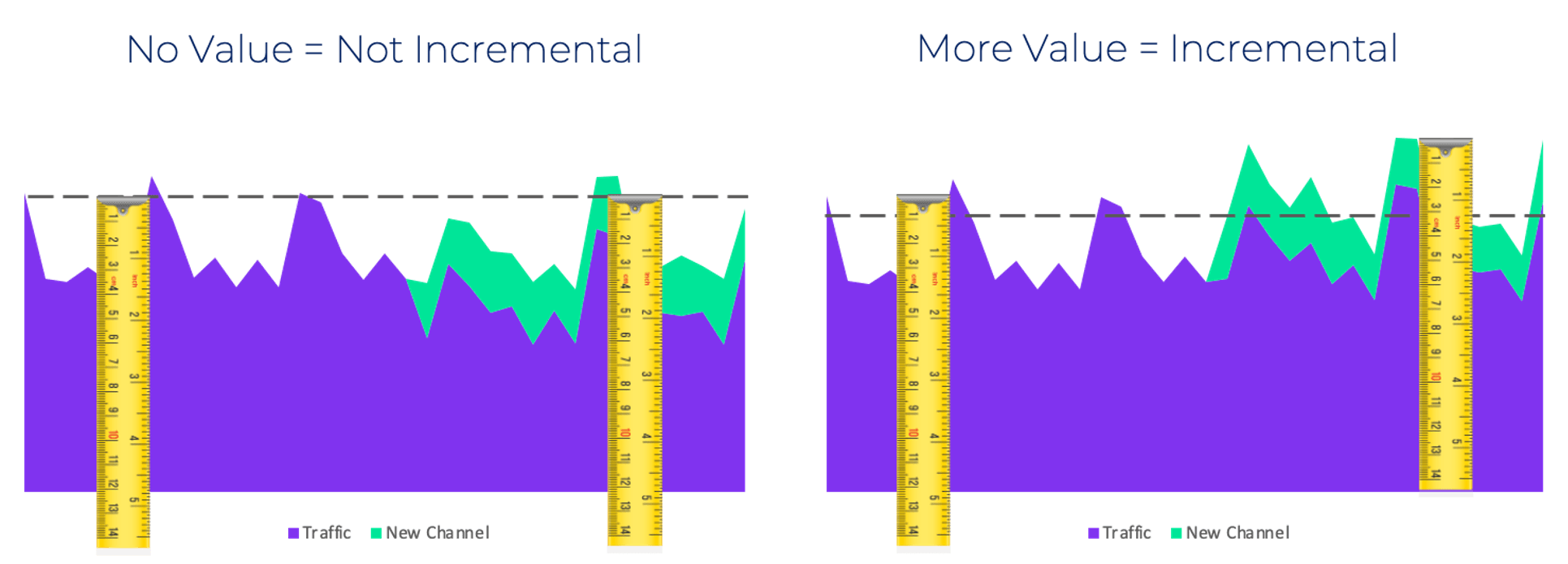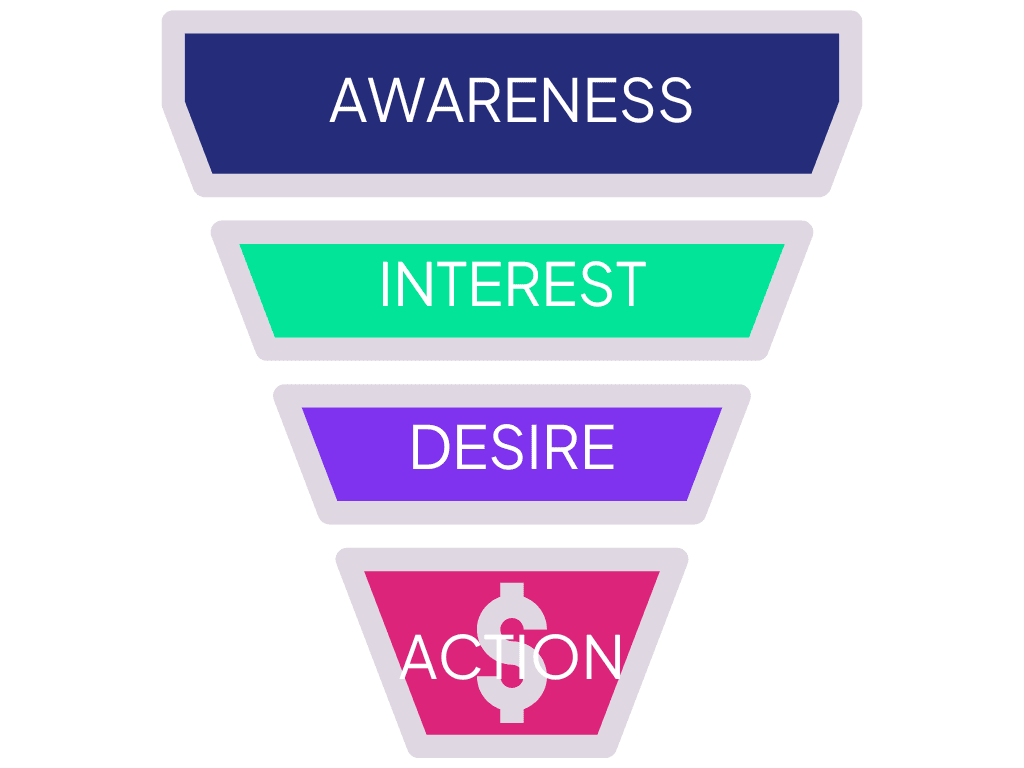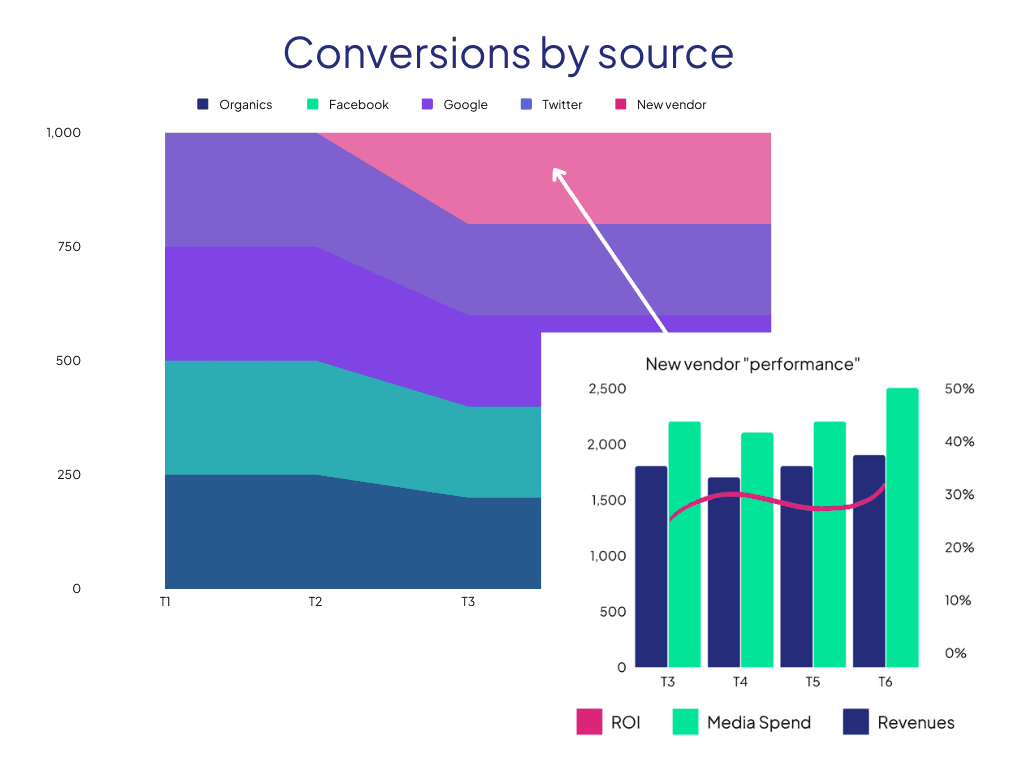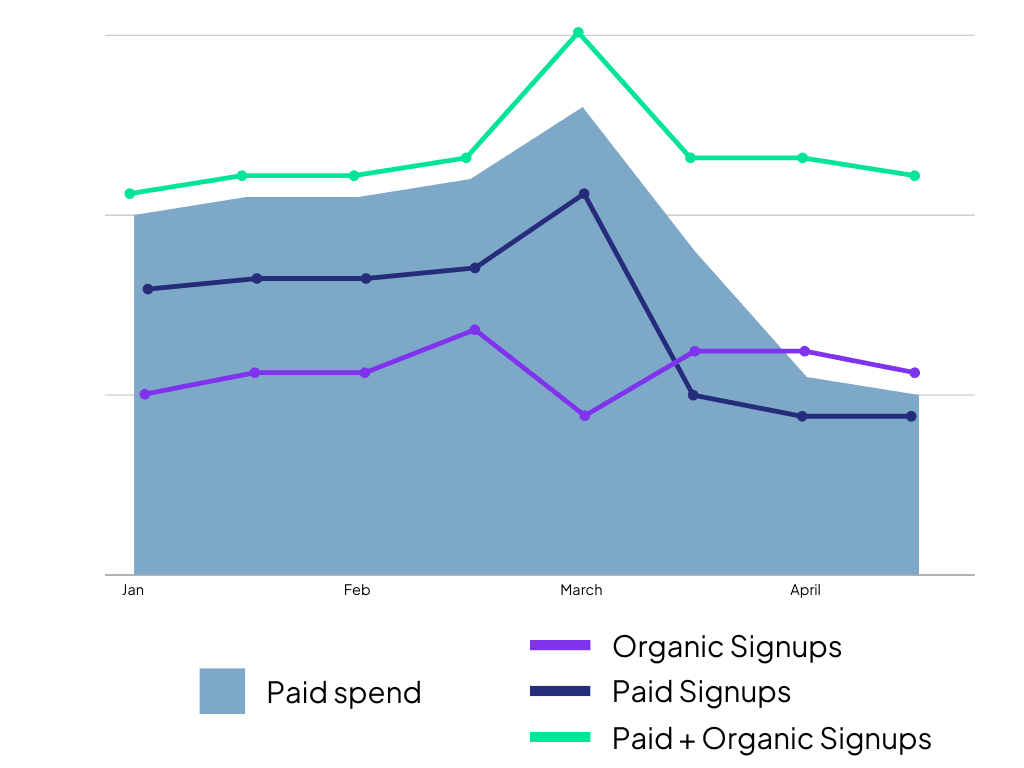Solutions
Teams
Built for your whole team.
Industries
Trusted by all verticals.
Mediums
Measure any type of ad spend
Platform
Use Cases
Many Possibilities. One Platform.
AI and Automation
The Always-on Incrementality Platform
Teams
Built for your whole team.
Industries
Trusted by all verticals.
Mediums
Measure any type of ad spend
Use Cases
Many Possibilities. One Platform.
AI and Automation
The Always-on Incrementality Platform

What is incrementality in marketing? It’s the key to understanding which campaigns truly drive growth and which only appear to perform. Incrementality marketing helps businesses focus on actions that genuinely add value, ensuring every marketing dollar counts.
At INCRMNTAL, we help marketers uncover the real impact of their campaigns. Without measuring incrementality, it’s easy to overspend on strategies that don’t deliver meaningful results. This article will guide you through why incrementality matters and how to measure it effectively
Incrementality is the measure of the additional impact or lift generated by a marketing activity beyond what would have happened without it.
Incrementality measures the impact a marketing channel, campaign or change has on any KPI. One of the best things about an always-on incrementality measurement is that you do not have to stop any of your marketing activities to be able to measure their impact on one another or your KPIs.
In the context of ads, it can be referred to as the measurement of ad effectiveness and it measures the true effectiveness of advertising activities irregardless of tracking.
A clear incrementality definition helps marketers understand how to separate genuine campaign-driven results from outcomes that would have occurred organically.
The goal of paid advertising is to create incremental revenues. Whether if it is to establish a stronger brand equity, or to push people to complete a purchase, download an app or use it.
Incrementality in marketing is vital to distinguish between results that were truly driven by advertising and those that were not.
If you want to fully grasp what is incrementality in marketing, you must realize it shows the true added value from marketing efforts, beyond what would have naturally happened.
Incrementality testing requires Advertising to create various scenarios to isolate conversions data. Tests use changes in the marketing activities to compare how a change in activity influenced campaigns performance over time.
The goal for marketing in any organization is to drive growth by driving customers and prospects through the marketing funnel. Awareness > Interest > Desire > Action
Advertising efficiency is reached when the Advertising budget spend produces results that would not have happened if it was not for the Advertising activities.
Measuring incrementality is the best way to ensure that the sales results (attributed to paid marketing) are results that would not happen if it was not for the advertising activities.
Without incrementality measurement, advertisers could be spending advertising budget continuously, believing that their advertising activities are producing incremental sales, while the reality could be that the activities are actually cannibalizing sales that would already happen without advertising - a common issue known as Paid Media Cannibalization.
Incremental sales lift has long been the goal of marketing, and incrementality measurement is the key to proving true impact. If you want to understand what is incrementality in marketing, it’s important to note that traditional models often fail to isolate the real lift generated by campaigns.
In the past, methods like control groups, PSA or Ghost Ads, and even ad blackouts were used to test incrementality, but they often produced biased or costly results. At INCRMNTAL, we recognized that the real challenge was knowing what a user would have done without exposure to ads and the answer is, we can’t.
Instead, modern incrementality measurement does not rely solely on experimentation, but on smarter approaches that reveal the true added value of marketing.
Our initial idea was: we will build “better attribution”. We wanted to build an attribution solution based on 1st party data, and apply machine learning to understanding the multiple touch points a user has with ads.
But this was a moot point - multi-touch is practically impossible in the mobile app ecosystem, as user data is becoming obsolete. This shift became even more evident after Apple’s announcement that “IDFA is dead in WWDC,” marking a fundamental change in how mobile advertising data could be tracked.
We also figured that attempting to help developers by offering a new measurement SDK is not helping the developers. No one wants to integrate another SDK.
Our research, had us understand that developers are not in need of “better attribution” - attribution as it is - is ok. But attribution can lead to terrible outcomes.
Once we established a few ground rules, we had our direction
There are several proven methods to measure incrementality in marketing. Each approach helps marketers understand the true impact of their activities by isolating results that would not have happened otherwise. The most common incrementality analysis methods include:
Causal inference uses statistical modeling to estimate the relationship between marketing activities and outcomes. By analyzing large datasets, it helps determine whether a specific campaign actually caused a lift in performance, rather than just correlating with it.
One of the most straightforward ways to test incrementality is through A/B testing. By splitting your audience into a test group (exposed to ads) and a control group (not exposed), you can directly compare results to measure the true incremental effect of advertising.
In a budget holdout test, a portion of the marketing budget is intentionally withheld from a specific audience or channel. Comparing the performance of audiences with and without spend provides insights into the incremental value of that budget allocation.
Geo-lift studies measure incrementality by targeting specific geographic areas with campaigns while holding out others as controls. This method is especially effective for measuring the impact of localized campaigns and understanding regional differences in ad effectiveness.
At INCRMNTAL, we've developed a groundbreaking methodology that eliminates the need for traditional experiments like A/B tests or randomized trials. Our approach measures marketing performance reliably in complex, noisy environments using advanced automation and causal discovery techniques.
We automate the collection of marketing data from all platforms, inferring activities from costs when direct support isn't available. To provide a fuller picture, we enhance this data with external factors including weather patterns, stock market trends, Google search trends, and holidays. Each activity receives a dynamic importance score based on its type, volume, timing, context, and other entity-specific features.
Our ensemble approach combines multiple time-series models (ARIMA, Prophet, and Causal Impact) to predict baseline outcomes without interventions. The system dynamically selects optimal training windows from weeks of historical data, splitting it into training and validation sets. Models are scored using metrics like MAPE (Mean Absolute Percentage Error), and their weighted results produce a final prediction with a 95% confidence interval.
To account for overlapping marketing activities, our causal discovery algorithm distributes observed effects across interventions. It incorporates contextual details like activity type, platform, adstock (carryover effects), timing, and location. Using reinforcement learning, the system continuously learns and updates expected behavior for each activity, ensuring accurate insights into both short- and long-term effects.
Rather than measuring at single points in time, our continuous measurement algorithm evaluates marketing activities over time, providing a consistent baseline for comparison. The system calculates both marginal values (incremental contributions) and absolute values (total impact), refining predictions daily as it adapts to new data and evolving marketing dynamics.
(short answer: no)
The role of advertising within the marketing space is to attract customers, especially new customers, to engage with a brand, leading them within a 4 stage funnel.

Advertising is most effective when it produces incremental results – i.e. sales that would not have happened if it was not for the advertising activities.
During the LUMA Digital Marketing Summit keynote presentation, LUMA presented the following slide saying: “True Attribution Focuses on Incrementality”
Marketing is a broad term describing a company’s activities to promote the sales of a product.
Each element in the 4 Marketing Ps may influence a successful marketing strategy:
In today’s competitive world, advertising activities are a necessary part of almost every product in the market. If you are a mobile app developer, you are competing against thousands of app companies from around the world.
Media vendors have made advertising lucrative by offering performance pricing schemes where advertisers can sit back and pay conversions rather than risk the costs of media which may not lead to any conversions.
While it’s tempting to advertisers – performance pricing has one big caveat – it incentivizes media vendors to optimize their own media strategy towards the low-hanging fruit: Targeting users that may likely would have converted, thus reducing the media inventory that is required to be used.
The following graph shows that an advertiser may launch campaign activities with a new vendor. Based on reporting – the new vendor is providing great value and a positive ROI.
 However, zooming out to see the bigger picture, shows that this new vendor does not contribute to the total volume of conversions, but is receiving credit away from the organic traffic.
However, zooming out to see the bigger picture, shows that this new vendor does not contribute to the total volume of conversions, but is receiving credit away from the organic traffic.
This vendor may have a high overlap with organic users.
Understanding incrementality can be very simple, but may require a marketer to make a drastic move – stop all advertising activities for a while, to see what happens…. 😬
Using the unique feature built by INCRMNTAL, marketers can use Time Machine to measure incrementality of past campaigns and actions.
You may be surprised that large companies who stopped all advertising activities found that up to 80% of their advertising activities were redundant, sometimes including fraudulent publisher activities, and this was while using the latest mobile measurement and analytics technologies available.

Most marketers are unwilling to perform such a drastic step – as while saving is important – most marketers would rather unlock the value of their spend rather than “save it”. Or in other words, cut the right marketing spend.
While the above example shows a clear picture of cannibalization, the reality for most marketing campaigns is more subtle.
An alternative solution to “Stop all Advertising” is available, by utilizing differences in different algorithms and examining the traffic mix on a narrow signal level. Utilizing algorithms allows a platform to continuously compare signals to signals on a combination level and point out opportunities for optimization based on incremental value while reducing cannibalization.
You can explore the different techniques in more detail through our guide on incrementality measurement. For marketers exploring broader measurement strategies beyond just incrementality, MMM modeling offers another valuable approach to understanding the effectiveness of marketing investments across multiple channels.
Ready to Get Started?
Understanding incrementality is just the beginning, putting it into practice can unlock real growth for your business. Discover how our platform can help you measure true impact and optimize every marketing dollar.
No, incrementality measurement complements traditional KPIs like ROAS, CPA, or CTR by adding a layer of causality. It helps determine whether those metrics reflect true value or are just capturing noise from non-incremental conversions.
Yes, even with a small budget, incrementality measurement can help identify where spend is generating real value. The goal is to optimize every dollar, not just scale large campaigns.
Not necessarily. Modern incrementality platforms, like INCRMNTAL, use aggregated and enriched data combined with advanced modeling techniques to assess impact without relying on raw user-level data.
Yes, while it's more challenging, incrementality can be applied to organic efforts like SEO, content marketing, or email to understand their impact in driving new conversions or revenue uplift.
Incrementality should be measured continuously or on a regular cadence, especially when running multiple campaigns or changing strategies. Real-time or always-on measurement allows for ongoing optimization.

Maor is the CEO & Co-Founder at INCRMNTAL. With over 20 years of experience in the adtech and marketing technology space, Maor is well known as a thought leader in the areas of marketing measurement. Previously acting as Managing Director International at inneractive (acquired by Fyber), and as CEO at Applift (acquired by MGI/Verve Group)